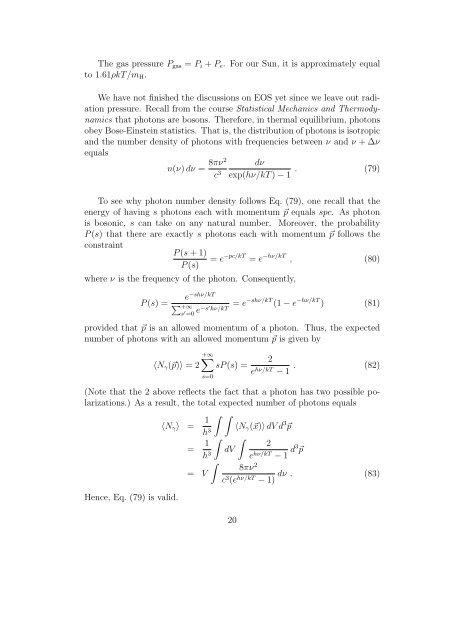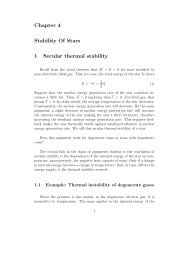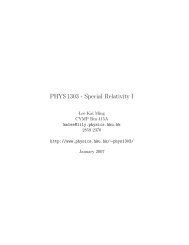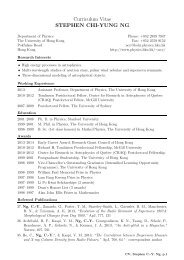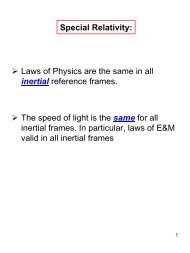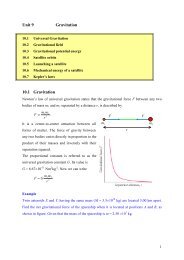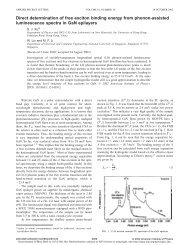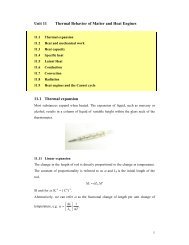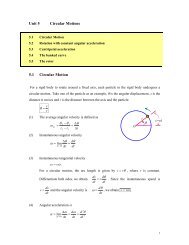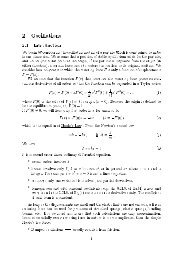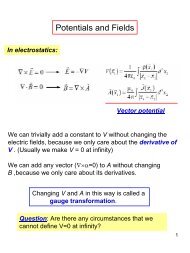Chapter 2 Stellar Structure Equations 1 Mass conservation equation
Chapter 2 Stellar Structure Equations 1 Mass conservation equation
Chapter 2 Stellar Structure Equations 1 Mass conservation equation
You also want an ePaper? Increase the reach of your titles
YUMPU automatically turns print PDFs into web optimized ePapers that Google loves.
The gas pressure P gas = P i + P e . For our Sun, it is approximately equal<br />
to 1.61ρkT/m H .<br />
We have not finished the discussions on EOS yet since we leave out radiation<br />
pressure. Recall from the course Statistical Mechanics and Thermodynamics<br />
that photons are bosons. Therefore, in thermal equilibrium, photons<br />
obey Bose-Einstein statistics. That is, the distribution of photons is isotropic<br />
and the number density of photons with frequencies between ν and ν + ∆ν<br />
equals<br />
n(ν) dν = 8πν2<br />
c 3<br />
dν<br />
exp(hν/kT ) − 1 . (79)<br />
To see why photon number density follows Eq. (79), one recall that the<br />
energy of having s photons each with momentum ⃗p equals spc. As photon<br />
is bosonic, s can take on any natural number. Moreover, the probability<br />
P (s) that there are exactly s photons each with momentum ⃗p follows the<br />
constraint<br />
P (s + 1)<br />
= e −pc/kT = e −hν/kT , (80)<br />
P (s)<br />
where ν is the frequency of the photon. Consequently,<br />
P (s) =<br />
e −shν/kT<br />
∑ +∞<br />
s ′ =0 e−s′ hν/kT = e−shν/kT (1 − e −hν/kT ) (81)<br />
provided that ⃗p is an allowed momentum of a photon. Thus, the expected<br />
number of photons with an allowed momentum ⃗p is given by<br />
⟨N γ (⃗p)⟩ = 2<br />
+∞∑<br />
s=0<br />
sP (s) =<br />
2<br />
e hν/kT − 1 . (82)<br />
(Note that the 2 above reflects the fact that a photon has two possible polarizations.)<br />
As a result, the total expected number of photons equals<br />
⟨N γ ⟩ = 1 ∫ ∫<br />
⟨N<br />
h 3 γ (⃗x)⟩ dV d 3 ⃗p<br />
= 1 ∫ ∫<br />
2<br />
dV<br />
h 3 e hν/kT − 1 d3 ⃗p<br />
Hence, Eq. (79) is valid.<br />
= V<br />
∫<br />
8πν 2<br />
dν . (83)<br />
c 3 (e hν/kT − 1)<br />
20


